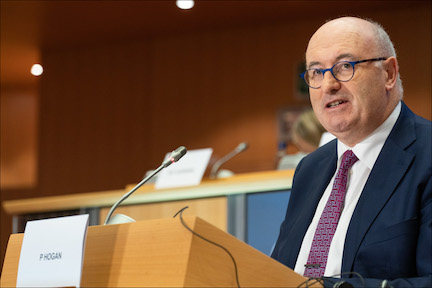China faces stepped-up calls to slash trade-distorting subsidies
China came under greater international pressure to reduce industrial subsidies after the U.S., Europe and Japan agreed to push for stronger World Trade Organization rules against market-distorting government aid.
The top trade officials of the U.S., the European Union and Japan struck a deal on Tuesday in Washington to expand the kinds of subsidies prohibited by the WTO. The announcement came on the eve of a planned signing ceremony at the White House for phase one of a U.S.-China trade deal, which doesn’t address Beijing’s support for domestic companies that compete internationally.
The subsidies accord—a breakthrough after years of deliberations—targets Chinese practices that have been a source of growing tensions between China and the rest of the world including the U.S., the EU and Japan.
This “is an important step toward addressing some of the fundamental issues distorting global trade,” EU Trade Commissioner Phil Hogan said in a statement. The accord “is also a symbol of a constructive strategic collaboration between three major players.”

Trade Truce
The joint initiative may signal a path for de-escalating international commercial tensions triggered by U.S. President Donald Trump’s trade war against China, curbs on imports from the EU and assault on the WTO system.
The Trump administration is gearing up for negotiations with China on a second-phase trade accord following the initial deal due to be signed on Wednesday. Meanwhile, the EU is scrambling to bolster the multilateral trade order underpinned by the WTO by seeking to address U.S. concerns.
Under the agreement among the U.S., the EU and Japan, the list of subsidies unconditionally outlawed by the Geneva-based WTO would be broadened to cover:
- unlimited guarantees
- aid to ailing businesses that have no credible restructuring plan
- support for companies unable to obtain long-term financing or investment from independent commercial sources operating in industries in overcapacity
- some direct forgiveness of debt
In addition, the deal would make it harder for countries to justify a range of other types of subsidies by reversing the burden of proof. The subsidizing nation would have to show that the aid in question has no serious negative trade effects.
Broader Support
If ultimately enacted, the agreement could represent the most significant upgrade of the global trade rulebook in more than a decade.
Currently, about 64% of global exports must compete with subsidized rivals, according to researchers at the Global Trade Alert, which tracks global subsidies. In 2017, that trade would have been worth $11.3 trillion.
Ultimately, the U.S., EU and Japan want to win support for their deal among a group of like-minded WTO members so it can become a wider agreement. That would allow members to sidestep a WTO requirement that all accords must be made by a consensus among its 164 members.
A key question is how to win over China.
Since 2001, China’s steel production capacity has grown by more than 500% and now accounts for more than half of global output of the metal, the U.S. said during a 2019 WTO meeting in Geneva. In the aluminum sector, four of the world’s top five recipients of government support are Chinese companies, according to a 2019 OECD report.
Trump administration officials have pledged to tackle the issue in phase two of their trade talks with Beijing.
Similar Stories
October 2024 crude steel production
Africa produced 2.0 Mt in October 2024, down 0.4% on October 2023. Asia and Oceania produced 110.3 Mt, up 0.9%. The EU (27) produced 11.3 Mt, up 5.7%. Europe, Other…
View Article
Descartes’ Foreign Trade Zone solution simplifies customs clearance for ALS
View Article
DHL Global Connectedness Tracker: No sign of globalization in reverse, international trade resilient
View ArticleDHL Global Connectedness Tracker: Globalization remains at a record level, despite geopolitical tensions and uncertainties
View Article
Brian Oravec appointed as Chief Investment Officer, Asia Pacific at Realterm
View Article
CBP intercepts over $30 million in methamphetamine at the Pharr International Bridge
View ArticleGet the most up-to-date trending news!
SubscribeIndustry updates and weekly newsletter direct to your inbox!





